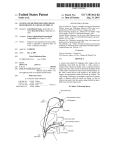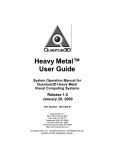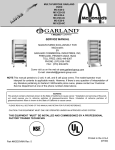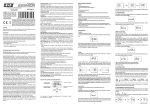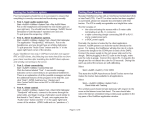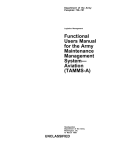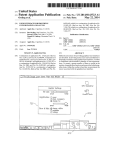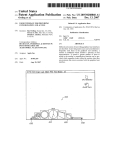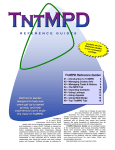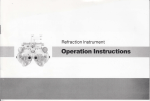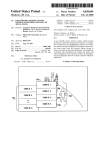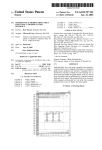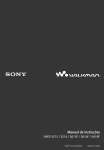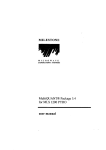Download Scales et al.
Transcript
US008817103B2 (12) United States Patent Scales et al. (54) (75) SYSTEM AND METHOD FOR VIDEO IMAGE REGISTRATION IN A HEADS UP DISPLAY Inventors: John Richard Scales, Huntsville, AL (US); Mark David Hose, Hunstville, AL (Us) (56) Corporation, McLean, VA (US) (*) Subject to any disclaimer, the term of this patent is extended or adjusted under 35 U.S.C. 154(b) by 998 days. This patent is subject to a terminal dis claimer. (21) Appl. No.: 12/843,842 *Aug. 26, 2014 References Cited U.S. PATENT DOCUMENTS 6,963,800 7,002,551 7,277,118 2006/0116814 B1 B2 B2 A1 11/2005 2/2006 10/2007 6/2006 Milbert Azuma et a1. Foote Milbert OTHER PUBLICATIONS (73) Assignee: Science Applications International Notice: US 8,817,103 B2 (10) Patent N0.: (45) Date of Patent: QUANTUM3D, Inc., Daggers: Embedded Training for Dismounted Soldiers Scients and Technology Objective (STO), http://www. quantum3d.com/PDF/sstories/SStoriesiDaggers.pdf, 2004. Sensor Technology Systems, Inc., Model 2733 Low Pro?le / Night Vision Goggle: AN/PVS-2l: Operational Summary, 2004. National Defense Magazine, Can the Army Make Objective Force Warrior W0rk?, http://www.nationaldefensemagazine.org/articl. cfm?Id:1173, Aug. 2003. Intersense, Inc., Intersense InertiaCube2, http://www.isense.com/ products/prec/ic2/InertiaCube2.pdf, 2004. Yeh, Michelle, et al., “Effects of Frame of Reference and Viewing (22) Filed: Jul. 26, 2010 Condition on Attentional Issues with Helmet Mounted Displays”, Technical Report, Jan. 1998, pp. 1-75. (65) Prior Publication Data US 2010/0289724 A1 (Continued) Nov. 18,2010 Primary Examiner * Young Lee (74) Attorney, Agent, or Firm * Banner & Witcoff, Ltd. (57) Related U.S. Application Data (62) Division of application No. 11/000,934, ?led on Dec. 2, 2004, now Pat. No. 7,787,012. (51) Int. Cl. H04N 7/18 U.S. Cl. (52) USPC (58) on the relative orientations of the camera and the display. As the video camera moves with respect to the display, the (2006.01) ........................................................ .. 348/158 Field of Classi?cation Search CPC ................................................. .. G02B 27/0172 USPC .. ABSTRACT A system and method for aligning video images with an underlying visual ?eld are provided. A video camera is coupled with a heads up display, and a computer positions images from the video camera on the heads up display based .. 348/158, 218.1 IPC ....................................................... .. H04N 7/ 18 images are repositioned within the heads up display. The video image, which may, for example, come from a weapon sight, is aligned within the heads up display so that an observer can easily view the camera image without having to shift focus from the larger scene. See application ?le for complete search history. 12 Claims, 10 Drawing Sheets 500 (infantryman) 506 (orientation sensor) 505 (goggles) 501 (computer) US 8,817,103 B2 Page 2 (56) References Cited Primordial Soldier: Geographically-Enabled Augmented Reality OTHER PUBLICATIONS loaded from <http://www.primordial.com> on Dec. 1 l, 2006, date of ?rst publication not known, 35 pages. “Primordial Soldier User manual”, downloaded from <http://www. primordial.com> on Dec. 11, 2006, date of ?rst publication not known, 26 pages. System for Dismounted Soldiers (A05-ll9), Presentation, down Livingston, MarkA., et a1 ., “Evaluating System Capabilities and User Performance in the Battle?eld Augmented Reality System”, pub lished in Proc. NIST/DARPA Workshop on Performance Metrics for Intelligent Systems, Gaithersburg, MD, Aug. 24-26, 2004. Hicks, Jeffrey, et al., “Eyekon: distributed Augmented Reality for Solider Teams”, published in 21st Century Systems, Inc., 2001-2003, pp. 1-14. “Competitive Analysis: Ground Guidance”, downloaded from <http://www.primordial.com> on Dec. 11, 2006, date of ?rst publi cation not known, 9 pages. “Whitepaper: Ground Guidance”, downloaded from <http://www. primordial.com> on Dec. 11, 2006, date of ?rst publication not known, 15 pages. “Primordial Soldier: Vision System for Soldiers”, Product Sheet, downloaded from <http://www.primordial.com> on Dec. 11, 2006, date of ?rst publication not known, 2 pages. “Primordial Soldier, Vision system software for soldiers”, down loaded from <http://www.primordial.com> on Dec. 1 l, 2006, date of ?rst publication not known, 6 pages. “Competitive Analysis: Unit Detection, Differentiating friend from foe and assessing threats in a soldier’ s head-mounted display”, down loaded from <http://www.primordial.com> on Dec. 1 l, 2006, date of ?rst publication not known, 8 pages. “Whitepaper: Unit Detection, Differentiating friend from foe and assessing threats in a soldier’s head-mounted display”, downloaded from <http://www.primordial.com> on Dec. 11, 2006, date of ?rst publication not known, 16 pages. US. Patent Aug. 26, 2014 101 (night vision goggles visual field) Sheet 1 0f 10 102 (video feed from weapon sight) FIG. 1 (PRIOR ART) US 8,817,103 B2 US. Patent Aug. 26, 2014 Sheet 2 0f 10 US 8,817,103 B2 200 (night vision goggles visual fieid) 300 (video camera 301 (cross image) hairs) FIG. 2 400 (visual field) 401 (weapon sight video feed) FIG. 4 US. Patent Aug. 26, 2014 Sheet 3 0f 10 US 8,817,103 B2 500 (infantryman) 506 (orientation sensor) 505 (goggles) 513 (cable) '- 512 (cable) ' 503 (video gun sight) 504 (orientation sensor) 502 (rifle) 510 (cable) 501 (computer) FIG. 5 US. Patent Aug. 26, 2014 Sheet 4 0f 10 US 8,817,103 B2 SENSOR 606 visua! ?eld ‘ < < BEAM COMBINER 605 COMPUTER 601 VIDEO SOURCE 602 | | l | | i i I I l SENSOR : 603 | | § ViDEO z i US. Patent Aug. 26, 2014 Sheet 5 0f 10 US 8,817,103 B2 I i l I I , I I I COMPUTER i I I x , I , | I I I I I g ! , I I , i I < x , I , I g ! , l I I , 710 k,\ HO INTERFACE vaO INTERFACE 704 705 II II i NETWORK glNTERFACE 5 706 iI II II II PROCESSOR MEMORY 701 702 D$PLAY INTERFACE 703 I I I I 5 I I I > ' I I I I I I I I I I I I i I I x , I , | I I I I I I I I US. Patent Aug. 26, 2014 US 8,817,103 B2 Sheet 6 0f 10 START 801 /_/ —I INITIATE DISPLAY I 802 F/ 803 RECEIVE ORIENTATION DATA RECEIVE ’ vIDEo FRAME CALCULATE PITCH & YAW DELTA VALUES I 808 Y F) CROP, RESIZE, & ENHANCE FRAME I 809 /_/ DISPLAY FRAME OVERLAYING VISUAL FIELD :05 DETERMINE FRAME LOCATION I A806 CALCULATE ROLL DELTA VALUE I 810 ANOTHER FRAME? FIG. 8 DETERMINE FRAME ROTATION :8 US. Patent Aug. 26, 2014 Sheet 7 0f 10 US 8,817,103 B2 sensor) FIG. 9A -16° +100 _8° 0° I I I I | I I I | I | I I I I +80 +16° I I | I | I I I | I | I I I I 0° : —: -100 921 (frame) - j 920 (visual _- field) ' FIG. QB US. Patent Aug. 26, 2014 US 8,817,103 B2 Sheet 8 0f 10 905 (orientation sensor) 901 (goggles) (orientation sensor) FIG. 10A -16° +100 _8° 0° l I l I | I l I | I l I l I | +80 +16° l I l I l I l I | I l I l I l 0° : _: 1021 (frame) _ 40° I920 (visual field) ' FIG. 1OB US. Patent Aug. 26, 2014 Sheet 9 0f 10 US 8,817,103 B2 905 (orientation sensor) 0 Y 901 (goggles) K i Z (orientation sensor) FIG. 11A -16° +10° O o 0° _8° ||||||||||||||| +80 +16° IIIIIIIIIIIIIII 1 121 (frame) I 920 (visual field) FIG. 11B US. Patent Aug. 26, 2014 Sheet 10 or 10 US 8,817,103 B2 905 (orientation sensor) 901 (goggles) Y X Z 911 (rifle) (orientation sensor) +100 -16° _8Q 0° +80 +16° llllllllllllllllllllllllllllll 0° _:- 1221 (frame) I 920 (visuai -10° _ FIG. 128 US 8,817,103 B2 1 2 SYSTEM AND METHOD FOR VIDEO IMAGE REGISTRATION IN A HEADS UP DISPLAY envisioned a technological revolution for the foot soldiers of tomorrow, dubbed Future Force Warrior. The project envi CROSS-REFERENCE TO RELATED APPLICATIONS sions, among other improvements, the porting of an infantry man’s weapon sight into a heads up display (HUD) built into his night vision goggles. Such goggles exist now, as in Sensor Technology Systems’ Model 2733 Low Pro?le Night Vision This application is a divisional of US. patent application Ser. No. 11/000,934, titled “System and Method for Video Image Registration in a Heads Up Display” and ?led Dec. 2, 2004, now US. Pat. No. 7,787,012, which application is Goggle. They have the ability to port a video feed into a beam combiner, overlaying a video image from a video source mounted in the weapon sight onto the center of the visual ?eld incorporated by reference herein in its entirety. An example of such a combined image appears as prior art FIG. 1. Here, the video feed 102 from a weapon’s sight is superimposed directly into the center of the night vision go g gle’s visual ?eld 101. This is accomplished using a beam combiner, which optically overlays one image over another. Both images depict the same subjects, a group of soldiers ofthe goggles. FIELD OF THE INVENTION The invention relates generally to the display of video images. More particularly, the invention provides a method and system for registering a video image with an underlying accompanying an armored personnel carrier (APC). How visual ?eld, such as in a heads up display. BACKGROUND OF THE INVENTION ever, the video feed 102 remains stationary in the center of the visual ?eld 101, obscuring content in the center of the visual 20 ?eld, in this case the APC and a soldier. The two images are distinctly offset, with the two soldiers to the right of the APC Modern warfare has seen its share of technological improvements which have led to weapons that can be targeted being repeated in both images. This offset, with two distinct images of the same target appearing in different places in the ?eld of view, could confuse the soldier, causing a delay in with ever increasing levels of speed and accuracy, enabling weapon operators to react more quickly when a situation 25 suddenly changes. While tanks, jets, missiles, combat plan ning systems, and other technological implements have kept engagement or a miss. If the soldier moves his weapon and turns his head simultaneously, the set of images moving in different directions may be even more confusing and disori pace with modern electronics, some familiar tools of modern enting to the soldier, potentially decreasing the soldier’s abil warfare have remained virtually unchanged for centuries. Perhaps foremost among these essential components is the infantryman: the soldier carrying light arms deployed on foot. ity to react and the accuracy of any shot ?red. Thus, it would be an advancement in the art if a video image from a video source could be integrated into the visual 30 Infantrymen have bene?ted to some extent from modern ?eld of a heads up display without con?lsing or disorienting technology with the advent of laser sights, night vision the observer, and without needlessly obscuring relevant goggles, and so forth. These have allowed the foot soldier to navigate at night, and accurately dispatch their targets. These technologies ultimately help to keep the soldier safe under the cover of darkness, help give the element of surprise when visual content. 35 SUMMARY OF THE INVENTION needed, and also help ensure that the ?rst shot ?red is the one that hits the mark. In spite of these advances, one problem which persists is the cumbersome process of acquiring and striking a target. At A ?rst embodiment of the invention provides a method for aligning video images with an underlying visual ?eld by 40 ing a display orientation of a transparent display overlaying the visual ?eld, and displaying video images in the transpar night, modern night vision goggles passively amplify minis cule amounts of ambient light, such as starlight, and enable a soldier to see obscured targets in the dark. Once a target is found in this fashion, however, a soldier must ?ip the goggles out of the way and reacquire the target with the sight on his weapon. This takes time away from the soldier, during which he might be seen by the target itself, or the target might move. In addition, reacquisition with the weapon’ s narrower ?eld of vision may be virtually impossible with a distant or moving determining a source orientation of a video source, determin 45 ent display, wherein a position for the images is based on the source orientation and the display orientation. A second embodiment of the invention provides a system for displaying a portion of a video feed overlaying a visual ?eld comprising a video camera, a heads up display (HUD), and a computer. Orientation sensors are af?xed to the video camera and the HUD. The computer is adapted to receive 50 target. sensor data from both orientation sensors, to receive the video feed from the video camera, and to display video images in the HUD. Alternatively, a soldier, upon viewing a target with night vision goggles, may engage a laser illuminator on his weapon. The illuminator projects a beam of laser light fol lowing the line of sight of the weapon and striking where the BRIEF DESCRIPTION OF THE DRAWINGS 55 FIG. 1 illustrates a prior art example of a stationary video feed overlaying a visual ?eld. FIG. 2 illustrates an example of a visual ?eld produced by bullet will strike. The soldier can keep his goggles on and see the illuminated point. He can move the point of the illumina tor until it points to his target, and then ?re as needed. While somewhat faster than lifting the goggles and reacquiring the target through the weapon sight, the illuminator may have the unintended effect of giving away the soldier’s position. The night vision goggles. 60 FIG. 4 illustrates the image produced by an illustrative laser illuminator may be just as obvious to an enemy as it is to the soldier. In the time it takes to maneuver his weapon into position, he may already be spotted and in the weapon sight of his enemy. In the hopes of solving this and other problems inherent with current infantry technology, US. military planners have FIG. 3 illustrates an example image from a video camera capturing the same scene as the visual ?eld of FIG. 2. 65 embodiment of the invention. FIG. 5 illustrates the system employed by an illustrative embodiment of the invention. FIG. 6 is a block diagram which depicts the functional components of an illustrative embodiment of the invention. US 8,817,103 B2 3 4 FIG. 7 is a block diagram which depicts the functional components of a computer employed by an illustrative embodiment of the invention. FIG. 8 illustrates a method for registering a video image with an underlying visual ?eld. FIG. 9A depicts an illustrative embodiment of the inven tion with a video source and heads up display visually discard unneeded visual information, cropping the image to perhaps one quarter of its original size. In addition, the video feed 401 has been positioned over the portion of the visual ?eld 400 based on the direction the video source is pointed. As the weapon moves, the video feed 401 is dynamically positioned within the visual ?eld 400. Ultimately, by super imposing the two images, a soldier with a heads up display aligned. and a weapon mounted video camera is able to simulta FIG. 9B illustrates a combined image created by the illus trative embodiment of FIG. 9A. FIG. 10A depicts an illustrative embodiment of the inven tion with a video source and heads up display visually offset neously survey a setting, acquire a target, and point his weapon at the target without taking time to shift from goggles to weapon sight. It should be noted upfront that this superimposition of horizontally. video images is not limited to weapon usage on a battle?eld, although that is the dominant example used here. Other FIG. 10B illustrates a combined image created by the illus trative embodiment of FIG. 10A. FIG. 11A depicts an illustrative embodiment of the inven tion with a video source and heads up display visually offset myriad of settings, including law enforcement, medicine, etc. vertically. provide a magni?ed view of an operating ?eld embedded within a view of the entire patient’ s chest cavity. An astrono FIG. 11B illustrates a combined image created by the illus trative embodiment of FIG. 11A. FIG. 12A depicts an illustrative embodiment of the inven tion with a video source and heads up display visually offset in rotation. FIG. 12B illustrates a combined image created by the illus trative embodiment of FIG. 12A. embodiments of the current invention could be used in a For example, a surgeon could use such a device on his hand to 20 mer could survey a star ?eld visually while wearing some form of heads up display. Her telescope could be ?tted with a video camera, the feed from which is dynamically fed into and positioned within the HUD. As such, she can view a 25 magni?ed video image from the telescope without having to reposition herself before the telescope’s eyepiece. Altema tively, her video source could produce a modi?ed output, perhaps displaying a color-shifted spectrographic view of the DETAILED DESCRIPTION OF THE INVENTION light from a particular star. Similarly, a nephologist can sur vey a sky full of clouds and simultaneously focus in on clouds FIG. 2 illustrates an example of a visual ?eld 200 as seen through the night vision goggles a foot soldier might wear. 30 of particular interest without shifting. An ichthyolo gi st, ?tted The image enhances ambient light, typically starlight, to with an underwater embodiment of the invention, could sur enable the soldier to see into the night. The visual ?eld depicts a handful of potential targets for the foot soldier. FIG. 3 vey a school of ?sh and simultaneously focus in on a particu lar ?sh. In each of these alternative embodiments, a secondary illustrates an example image 300 from a video camera cap turing the same scene as the visual feed of FIG. 2. The video camera producing the image 300 may be attached to a weapon video source is used to dynamically supplement an observer’ s 35 carried by the foot soldier. The image 300 may be the product of a specialized camera or weapon sight, such as a thermal imager which makes infrared wavelengths visible, a starlight scope which ampli?es ambient light using the same technol 40 ?eld of view. FIG. 5 illustrates a system employed by an illustrative embodiment of the invention. Here, an infantryman 500 is ?tted with goggles 505, a ri?e 502 with video gun sight 503, and ?eld computer 501. The goggles 505 may produce a visual ?eld similar to the one illustrated in FIG. 2. The video gun sight 503 produces a video feed, possibly including cross hairs as in FIG. 3, depicting the line of sight of the ri?e 502. ogy which enables night vision goggles, or any other video source such as a standard television camera. The video feed includes cross hairs 301 so that a soldier viewing the video The video weapon sight 503 may produce more than a stan feed will know exactly where a shot ?red will hit. In addition, the video camera may magnify the image to aid target recog dard unmagni?ed view, for example a magni?ed view, a thermal view, a night vision view, an image intensi?er view, 45 nition and to increase accuracy. or some combination thereof. The visual ?eld 200 and the video image 300 differ in their ?eld of view (FOV). The visual ?eld of the night vision goggles allows for a greater amount of visual information to In this embodiment, ?eld computer 501 receives a video feed from video weapon sight 503 via cable 512. The video feed may be delivered using any standard video format, for example analog formats like NTSC or PAL, or digital formats like MPEG, or any non-standard format. The ?eld computer be viewed by the observer simultaneously without the 50 observer having to move his head. The FOV of the video image 300, as from a weapon sight, is normally much nar rower, presenting less of the visual ?eld to the observer. As a result, a soldier looking directly through a weapon sight, or looking at the video feed produced by such a sight, will have 501 receives sensor data from orientation sensors 504 and 55 to move the weapon in order to view the entire scene. For this reason, soldiers may search for and acquire targets at night using the wider FOV of night vision goggles, and switch to the weapon sight view only once they have decided upon a target. This takes time, thus slowing down the soldier. The visual ?eld 400 of FIG. 4 illustrates the image pro duced by an illustrative embodiment of the invention. The visual ?eld 400, here the view through a soldier’s night vision goggles or other (clear) goggles, is enhanced with the addi tion of a portion of the weapon sight video feed 401 through the use of a heads up display (HUD). With this embodiment of the invention, the video feed 401 may be modi?ed so as to 60 65 506, via cables 510 and 511. Once the video feed is processed, ?eld computer 501 delivers video for the heads up display within the goggles 505, via cable 513. The sensor 504 a?ixed to ri?e 502 sends data relaying the orientation of the weapon and attached video gun sight 503. This data may include angular pitch, yaw, and roll informa tion, sent in frequent intervals. An example of such a sensor is InterSense’s IntertiaCube3®, which uses the earth’s gravita tional and magnetic ?elds (among other means) to sense and report angular orientation around three axes of rotation up to 180 times per second. The sensor 506 a?ixed to goggles 505 relays similar orientation data, except that it reports on the line of sight of the goggles instead of the ri?e 502. It should be noted that sensors 504 need not be directly a?ixed to the ri?e 502, so long as it moves with the ri?e. For example, it could US 8,817,103 B2 5 6 be attached to the gun sight 503. Likewise, sensor 506 need not be directly a?ixed to the goggles 505. The sensor 506 could also be attached to the helmet of the infantryman 500. In this embodiment, sensors 504, 506 use Universal Serial not be perfectly transparent, but also might be translucent allowing only some light to pass through. The video output of computer 601 is placed in front of the visual ?eld 610, creat ing what is sometimes referred to as a heads up display or HUD. Such displays allow an observer to receive information Bus (USB) cables 510, 511 to relay angular data, although any communication method is feasible. These cables, along or images while simultaneously viewing a visual ?eld, pre venting the observer from having to look away. FIG. 7 is a block diagram depicting the functional compo with video cables 512, 513 may either be exposed or sewn into a soldier’s clothing or his ri?e sling to prevent entangle ment of the wearer. Although wired sensors and video cables are used here, any form of wireless radio is feasible. For nents of a computer employed by an illustrative embodiment of the invention. The functional components of computer 601 illustrated here are merely representative of functions. Indi vidual functions may be combined or divided among multiple components within the device. Here, processor 701 is con nected to memory 702 via bus 710. Memory 702 may include example, Ultra-wideband (UWB) transceivers may transmit video and sensor data from the weapon, and sensor data from the goggles. Likewise, UWB may be used to transmit video from the ?eld computer 501 to the goggles 505. Although UWB radios, such as Time Domain’s PulsON® radio, are volatile memory, such as random access memory (RAM), or non-volatile memory, such as Flash or a hard disk drive. Also particularly desirable for their high bandwidth, low power consumption and for being virtually undetectable, any wire less standard may be used, including both Bluetooth and connected to processor 701 is Input/Output Interface 704, which may communicate with and pass data from connected IEEE 802.11. In alternative embodiments, UWB radios may be used for 20 more than transmission of video and sensor data. Multiple radios may be placed on the ri?e 502 and on the goggles 505 (or on the helmet, to which the goggles may be a?ixed), each of which can relay their precise position. In this fashion, the ?eld computer 501 may be able to calculate the alignment of USB or a wireless standard, such as UWB or Bluetooth. Video interface 705 receives video signals and relays them for stor age in memory 702 or processing in processor 701. Display interface 703 relays video signals to an external display, such 25 as the HUD. Optional network interface 706 may be used to communicate with an external computer, possibly to transmit and receive position and situational data (to other team mem bers, or via satellite back to headquarters). Bus 710 may be 30 cating between components. the ri?e and goggles based on the relative location of radios rather than use separate orientation sensors. In other alternative embodiments, the heads up display need not be connected to the viewer, as through a pair of night vision goggles. For example, the heads up display could peripherals, including orientation sensors, perhaps using comprised of a single or multiple signal buses for communi appear before a windshield in a vehicle. A weapon mounted FIG. 8 demonstrates an illustrative embodiment of a on the vehicle includes a video gun sight producing images processed and projected onto the heads up display. In this method for registering a video image with an underlying visual ?eld. It should be noted that the steps pictured here may be reordered, combined, or split to achieve a similar result. embodiment, an orientation sensor may be placed to sense the orientation of the vehicle rather than a pair of go ggles worn by the observer. This embodiment may be particularly useful for remotely controlled weapon systems, for example a robot 35 Step 801 initiates the method when the heads up display is initiated, either through a switch attached to a video source or gun sight, a switch on a computer, or perhaps on the heads up carrying a weapon. The current state of the art uses two display itself. Alternatively, the display may be initiated when screens, one for navigation and one for aiming the weapon. A robot operator uses one screen to drive the robot and acquire targets, then refers to an adjacent screen to aim and ?re the a weapon is removed from its safety setting. Once initiated, at step 802, a video frame is received for processing. The frame may be processed digitally, and if it is received in analog form 40 weapon. Registering the weapon video image to the naviga may ?rst need to be converted to a digital format for process mg. tion screen in a manner similar to an infantryman gamers similar advantages for the robot operator. Additionally, because a robot’s weapon is typically turret-mounted, sensors may be replaced with similar gear or other positional readouts based on turret position, laser range?nderposition, or weapon Along with the receipt of a video frame, orientation data 45 in the form of pitch, yaw, and roll angular values or in quar temions. Such values indicate the angle of vertical rise elevation position. FIG. 6 is a block diagram which depicts the functional components of an illustrative embodiment of the invention. Here, computer 601 receives sensor data and a video feed 50 from video assembly 604, along with sensor data from heads up display assembly 607. Video assembly 604 is composed of video source 602 and sensor 603 af?xed to detect the orien tation of the video source. Video source 602 has a visual ?eld 55 the difference in yaw values. By knowing the pitch delta and yaw delta, the location of the processed frame within a heads up display is determined, as in step 805. In determining the location, the pitch delta and yaw delta values are mapped signal delivered to computer 601. Heads up display assembly bined with the processed video signal delivered from com puter 601. This combination of video signal with visual ?eld may be created through the use of a transparent display, such as a piece of glass set at an angle. The glass may pass light from the visual ?eld 610 to the observer while simultaneously (pitch), the angle of horizontal rotation (yaw), and the angle of rotation around the line of sight (roll), for both the display and the video source. Having this data, in step 804, the dif ference in pitch and yaw values between the display and the video source can be calculated. The pitch delta is the differ ence in pitch values from the two sensors, and the yaw delta is 611 from which it receives light and converts it to the video 607 is composed of beam combiner 605 and sensor 606 a?ixed to detect the orientation of the beam combiner. Beam combiner 605 has a visual ?eld 610, whose image is com may be received from sensors attached to a heads up display and a video source, as in step 803. This data may be received from degrees to pixels. This calculation requires determining 60 the number of pixels in a degree of vision, and then multiply ing that number by the pitch delta and yaw delta values to determine vertical and horizontal offset from the center of the 65 visual ?eld in pixels. In step 806, the roll delta value is determined in similar fashion, by ?nding the difference between the roll values re?ecting light from a video display strategically placed sensed at the video source and display. Based on the roll delta, based on the angle of the glass. The transparent display need the processed frame can be rotated for presentation within the US 8,817,103 B2 7 8 heads up display, as in step 807. Various algorithms for rotat ing an image by a certain number of degrees are well known the heads up display goggles 901. The example visual ?eld in the art. horizontally (yaw) and 20 degrees vertically (pitch). If the Once the location and rotation of the processed frame within the display are determined, the frame may be cropped, discarding unneeded pixels, as in step 808. The frame may be resized in order to map the video information onto the pixels that will ultimately be used in a heads up display. This step may be necessary if the video images produced by a video pitch delta and yaw delta values are zero (i.e., the goggles and video source are aligned), then the frame 921 is displayed in the center of the visual ?eld 920, as shown here. The roll delta value is also zero here, because the ri?e 911 and goggles 901 are both rotationally aligned with each other aron their source are larger than needed for display. For example, if a out rotation. video image initially has a ?eld of view of 8 degrees horizon tal and 6 degrees vertical, it may be cropped down to 4 degrees horizontal and 3 degrees vertical, retaining the same center point. In this fashion, only a quarter of the image is retained, but it constitutes the most relevant part of the image. Alter however, the ri?e 911 has been rotated horizontally by 8 degrees to the left. FIG. 10B depicts the subsequent change in the visual ?eld 920. The pitch and roll values detected by 920 for the goggles 901 has a ?eld of view that is 32 degrees respective Z-axes. As such, the frame 921 is displayed with FIG. 10A depicts the same components as FIG. 9A. Here, natively, the video frame may need to be magni?ed or com pressed in order to adjust for differences in magni?cation between the visual ?eld and the native video frame. In addi tion, the frame may be enhanced by adding a border around the frame so as to further distinguish it from the visual ?eld 20 heads up display, shifting it to the left as shown. If the yaw value exceeds the visual ?eld width, the frame may still appear within the visual ?eld, but with a distinctive border, indicating to the user that the ri?e is pointing outside the for an observer. The processed video frame, at this point, may be displayed in a heads up display, as in step 809. The colored pixels of the processed frame are surrounded by dark or black pixels, which equate to transparent in a heads up display. The dis played frame appears before a visual ?eld from the perspec tive of an observer of the visual ?eld. The calculated position and rotational orientation of the processed frame place it on the display approximately in front of the same subject matter depicted in the visual ?eld. In addition to the frame itself, additional information may be added to the display, for orientation sensor 915 remain unchanged. However, the yaw value detected will change by 8 degrees to the left. When this is compared to the values detected by the orientation sensor 905 a?ixed to goggles 901, which haven’t changed, the yaw delta value will be —8 degrees. When processed, this yaw delta value will change the placement of the frame 1021 in the 25 visual ?eld. The frame remains visible, however, giving the user a view of where the weapon is pointing. The frame position will be in the direction of the actual weapon pointing direction, allowing the user to rapidly and instinctively adjust 30 his visual ?eld or his weapon to bring the two back together. FIG. 11A again depicts the same components as FIG. 9A. Here, the ri?e 911 has been rotated vertically (rather than example, battery life data. The ?nal display image, including horizontally) up 6 degrees. FIG. 11B depicts the subsequent the processed and repositioned video frame and any other information, is sent to the display, possibly using a standard change in the visual ?eld 920. The yaw and roll values detected by orientation sensor 915 remain unchanged, but the pitch value detected will change, up 6 degrees. When com pared to the unchanged values from the orientation sensor 905 video format such as 12-bit Video or NTSC. 35 At this point in the process, at decision 810, if another frame of video is set to be received (i.e., the display is still on), then the process repeats for each new frame, returning to step 802. In this fashion, each frame of video is individually pro ces sed, modifying the frame, positioning and rotating it based a?ixed to the goggles 901, the pitch value will be +6 degrees. When frame 1121 is processed, this pitch delta value will change the placement of the frame in the heads up display, 40 on the difference in orientations between the video source and the display, and then displaying it. As such, if the video source moves from left to right, then its orientation data will change, and subsequent displayed frames will move left to right across the visual ?eld, aligning or registering each frame with the portion of the visual ?eld it overlays. Once there are no shifting it up as shown. FIG. 12A is a ?nal depiction of the same components as FIG. 9A. Here, the ri?e 911 has been rolled aron its line of sight by 10 degrees, counterclockwise. FIG. 12B depicts the subsequent change in the visual ?eld 920. The pitch and yaw longer any frames to be processed (i.e., the display has been values detected by the ri?e’s orientation sensor 915 remain unchanged, but the roll value detected is different, counter clockwise 10 degrees. When compared to the unchanged turned off), the process comes to an end. values from the orientation sensor 905 af?xed to the goggles 45 FIG. 9A depicts an illustrative embodiment of the inven tion in the form of a video source 912 a?ixed to ri?e 911 and 50 heads up display goggles 901. The direction that ri?e 911 and video source 912 are pointing is sensed by orientation sensor 915. The line of sight for the video source is indicated by the Z-axis on axes 916. The direction that heads up display goggles 901 are pointing is sensed by orientation sensor 905. The line of sight for the goggles 901 is indicated by the Z-axis 55 901, the roll delta value will be 10 degrees. When frame 1221 is processed, this roll delta value will change the rotation of the frame in the heads up display, rotating it counterclock wise. It should be noted that although FIGS. 10A-12B depict only motion around a single axis at a time, the technique may be applied to motion in all directions. One possible consideration for the above described meth ods and systems is the problem of parallax. That is, because a on axes 906. Here, axes 906 and 916 are in alignment. The video source and a heads up display are separated by some goggles are looking in exactly the same direction as the weapon is pointed. As such, the orientation sensors 905 and 915 will output the same values for pitch, yaw and roll. distance (e.g. 0.5 meters), if both devices are perfectly aligned, they will in fact be looking at slightly different 60 The effect of this upon the heads up display is depicted in FIG. 9B, which illustrates a combined image created by the illustrative embodiment of FIG. 9A. When a frame 921 from the video source 912 is processed using an embodiment of the invention, it is placed in the center of the visual ?eld 920, as shown. Here, the visual ?eld is depicted with increments of degrees which represent the ?eld of view, in this case through 65 points. As a result, in processing a video frame, the location where the frame is placed may be slightly off, and a displayed frame of video will not be aligned as perfectly as possible. However, this problem diminishes as the distance to a target increases. The further away the target, the smaller the change in degrees, and hence the smaller the error produced. For example, a target at 10 meters with 0.5 meters between gun sight and goggles produces an error of about 2.9 degrees in the US 8,817,103 B2 9 10 placement of the video frame. At 100 meters, with the same 0.5 meters between gun sight and goggles, the error is only ciate that there are numerous variations and permutations of the above described systems and techniques. Thus, the spirit 0.29 degrees in the placement of the video frame. and scope of the invention should be construed broadly as set forth in the appended claims. The problem of parallax is to some extent a non-issue. The system proposed would likely be used for targets at distances We claim: greater than 10 meters more often than not. Moreover, when 1. A system comprising: targeting a weapon using the system, the video frame dis played in the heads up display will ultimately be the source of a video camera adapted to provide, in a video feed, data for a series of video images representing portions of a visual assurance that a soldier’s weapon is pointed at a proper target. ?eld; Even if a video gun sight image is slightly misaligned with the visual ?eld surrounding it, the soldier will primarily care that his weapon is pointed at the correct target. Further, the abso a ?rst orientation sensor adapted to detect an orientation of the video camera; a heads up display (HUD) adapted for viewing of the visual lute amount of misalignment will be only 0.5 meters at worst ?eldby a user of the system wherein the HUD comprises a transparent display, and wherein the HUD and the video camera are independently movable about multiple using the above example. The video gun sight image will still appear over or next to the intended target. Note that weapon accuracy is governed by zeroing the weapon and the video gun sight image, so parallax has no effect on bullet accuracy. To the extent that parallax is an issue, it can be handled in several ways. One solution is to integrate a range ?nder, such as a laser range ?nder, into the system to automatically detect axes; a second orientation sensor adapted to detect an orientation of the HUD; and 20 the distance of targets and, given a known weapon-goggle from the video camera, and to display the video images, distance, adjust the image placement accordingly. Another on the transparant display and based on the received solution is to provide a range adjustment control which a soldier can use to manually adjust the range to a target, and accordingly adjust image placement. Parallax may also be an issue when calibrating the orien tation sensors. Calibration may be required when initially con?guring the invention, and may also be required if a severe jolt to the system causes misalignment of the sensors. One solution may be to provide a button which is pushed to signal calibration. While holding the button, a reticle may appear in the center of the visual ?eld while the video image may appear motionless off to the side. Once the visual ?eld and sensor data, in positions that overlay portions of the 25 30 2. The system of claim 1, wherein the HUD is housed in a parallax will induce an angular error in closer targets, as described above. 40 4. The system of claim 1, wherein the ?rst orientation sensor is af?xed to the weapon and, While the invention has been described with respect to carrying out the invention, those skilled in the art will appre images. pair of night-vision goggles. 6. The system of claim 5, wherein the video camera is 45 attached to a weapon. 7. The system of claim 6, wherein the video camera is a thermal gun sight. 8. The system of claim 1, wherein the video camera is a such, well known rigid or non-rigid image registration tech niques may be used to register the images by, for example, speci?c examples including presently preferred modes of the computer is adapted to resize and crop the video 5. The system of claim 1, wherein the HUD is housed in a image, along with the video images from the video source, are both fed into a computer for initial digital processing. As the resultant combination of video image and goggle image. 3. The system of claim 1, wherein the video camera is attached to a weapon and the video feed is of a line of sight of the weapon. the video camera is a weapon sight attached to a weapon, Alternative embodiments may provide additional solutions to the issue of parallax. In one such embodiment, the image produced in the visual ?eld of a display is captured by a up display alone, or the heads up display may be ?lled with determine a source orientation of the video camera, and determine a display orientation of the transparent display. pair of goggles. 35 starting point from which to search the goggle image. Once the precise location of the video image is registered within the goggle image, the video image can be more accurately aligned. The video image may then be displayed in the heads wherein boundaries of the displayed video images are in registration with boundaries of portions of the visual ?eld represented by the displayed video images, and video image are both centered on the same target, releasing ?nding common visual elements between them. This process is accelerated by having, based on the orientation data, a visual ?eld represented by the displayed video images wherein the computer is adapted to the calibration button signals alignment to the system. The portion of the invention which calculates the position of the video image may then adjust its calculations accordingly. Centering on a distant target (for example, greater than 300 meters) during the calibration routine may be required as second video camera. This second video feed or goggle a computer adapted to receive sensor data from the ?rst and second orientation sensors, to receive the video feed 50 thermal gun sight. 9. The system of claim 1, wherein the computer is adapted to reposition the displayed video images within the transpar ent display when the video camera or transparent display moves. 10. The system of claim 9, wherein the video camera is attached to a weapon. 55 11. The system of claim 10, wherein the video feed is of a line of sight of the weapon. 12. The system of claim 1, wherein the computer is a ?eld computer adapted to be worn and carried by a human user. * * * * *

















